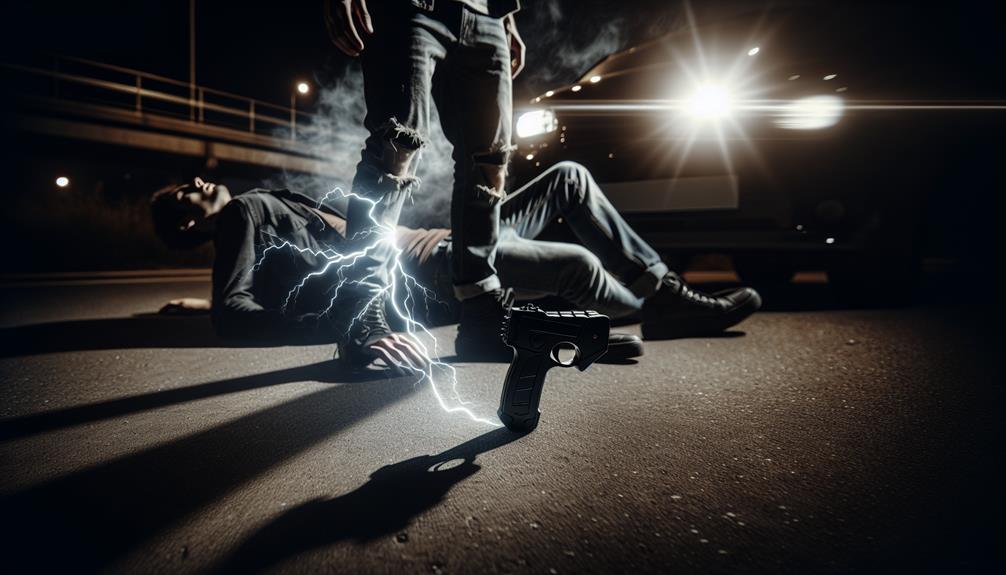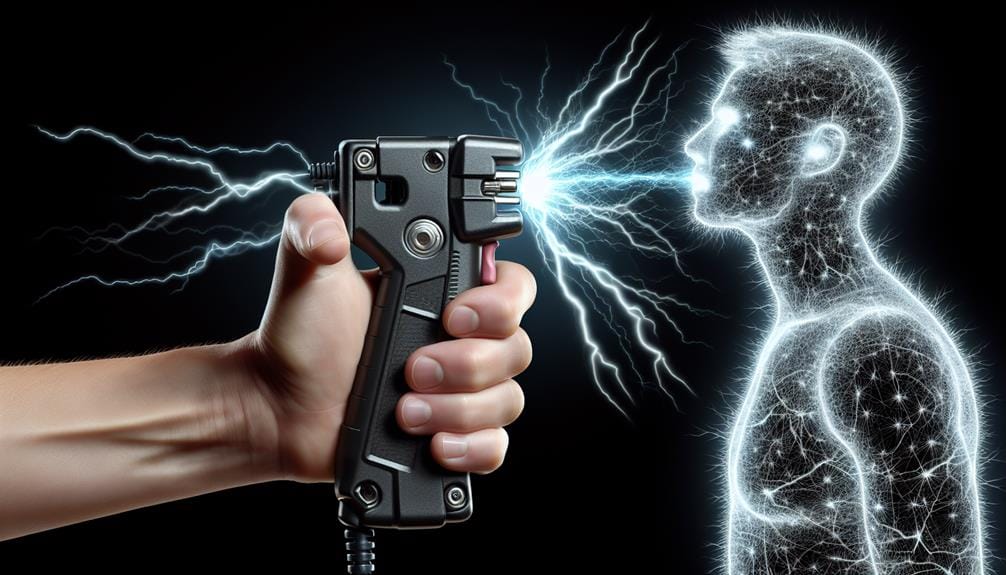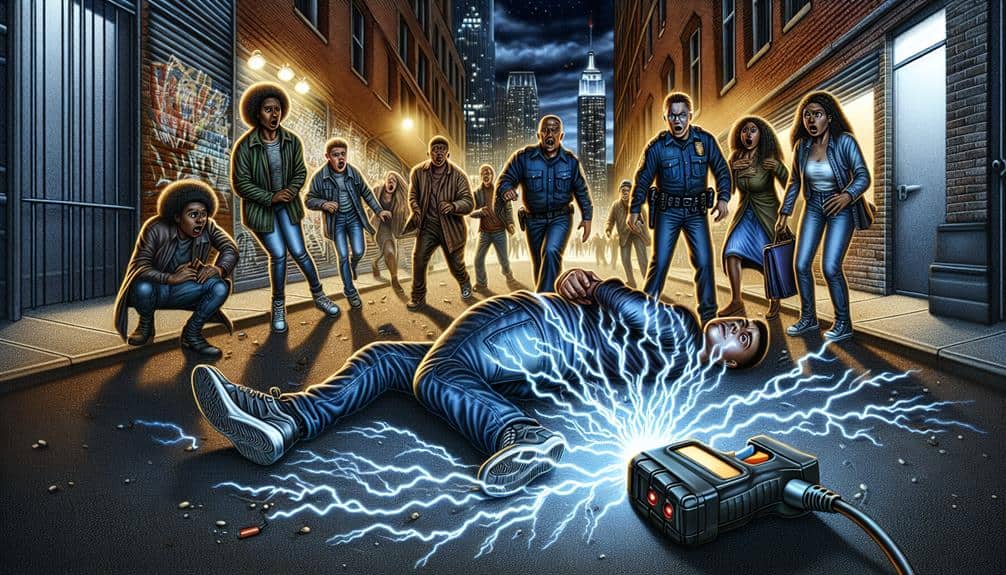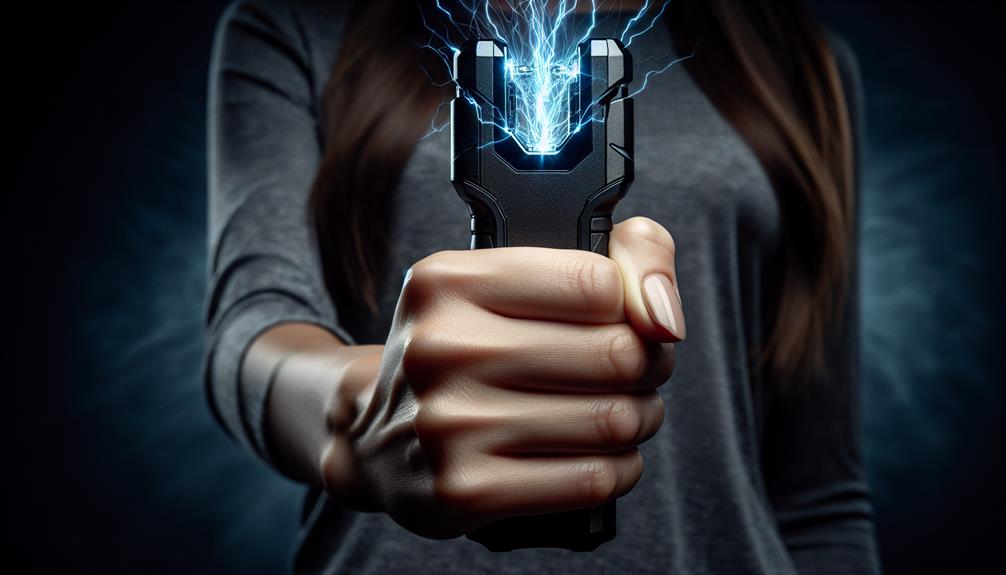Stunning Revelations: Can Stun Guns Really Make You Black Out?

Ever wondered if a stun gun could really make you black out? When hit by a stun gun, you’re hit with a high-voltage jolt that messes up your nervous system, causing intense pain and temporary paralysis. It’s like getting zapped by a lightning bolt—yikes! But, despite the dramatic effects, blackouts are super rare. Mostly, you’ll feel disoriented and dizzy, kind of like that time you spun in circles too many times as a kid. For those with heart conditions, though, things could get dicey. Want to dive deeper into the electrifying world of stun guns and their true impact? You’re in for a shock!
How Stun Guns Work

Stun guns operate by delivering a high-voltage, low-amperage electrical shock to interrupt your body’s neuromuscular system. When you activate a stun gun, it sends an electrical charge that zaps through the nervous system, causing those unmistakable muscle contractions. Imagine your muscles suddenly throwing a wild dance party without your permission—yeah, it’s like that.
The first stun gun was designed to be both effective and non-lethal. These devices usually crank out between 50,000 to 300,000 volts, enough to create a stunning effect without causing long-term damage. It’s like a lightning bolt in your hand, minus the catastrophic consequences.
Now, when you think about stun guns, picture a moment where your body’s internal communication lines go haywire. The electrical shock messes with the signals traveling between your brain and muscles, making them temporarily lose control. Your sensory and motor functions get scrambled, leading to some serious disorientation.
Stun guns are designed to incapacitate someone quickly, yet briefly. They’re effective tools for self-defense, providing peace of mind when you need it most. So, whether it’s the first stun gun or the latest model, these devices pack quite the punch, ensuring you’re always one step ahead.
Effects on the Human Body
When you get hit with a stun gun, it feels like your body’s been hijacked by a lightning bolt, and your nervous system goes haywire.
It can mess with your heart and blood flow too, making you feel dizzy and out of whack.
Imagine trying to walk straight while your brain’s doing somersaults—that’s the kind of chaos we’re talking about!
Nervous System Impact
A high voltage electric shock from a stun gun can overwhelm your nervous system, leading to severe muscle contractions and loss of control over bodily functions. Imagine feeling like a puppet with its strings cut—it’s that intense. These devices disrupt your sensory and motor nerves, which can leave you temporarily paralyzed and utterly disoriented.
When a stun gun hits you, it’s like your body goes haywire. Your brain can’t communicate properly with your legs, arms, or even your bladder. You might feel confused, unable to make sense of what’s happening around you. Your muscles seize up, making you drop to the ground like a sack of potatoes. This isn’t just about losing balance; it’s about losing control.
The shock targets your central nervous system, scrambling signals between your brain and body. It’s almost like someone hit the reset button on your control panel. Some people even black out or lose consciousness because their nervous system is so overloaded. These effects vary from person to person, but the chaos inside your body remains the same. It’s a mind-boggling experience that leaves you dazed and immobilized, wondering what just happened.
Heart and Circulation
Ever wondered how a stun gun‘s jolt affects your heart and circulation? Let’s explore the electrifying details!
When a stun gun hits you, it doesn’t just zap your nerves; it can seriously mess with your heart rate and blood pressure too. That jolt of electricity can cause irregular heart rhythms, disrupting the natural electrical signals your heart relies on to pump effectively. Imagine your heart suddenly racing, trying to keep up with the chaos—it’s not exactly a smooth ride.
The surge in electrical current can make your heart beat faster and your blood pressure spike, almost like you’ve just run a marathon without moving an inch. These circulatory effects can lead to dizziness, fainting, or even blacking out. And if you’ve got pre-existing heart conditions, a stun gun’s shock can be downright dangerous.
Pain Vs. Incapacitation
Stun guns deliver a jolt of electricity that causes intense pain and muscle contractions, making it difficult for an attacker to continue their assault. Imagine, you’re hit with a zap, and suddenly, your muscles feel like they’ve turned to jelly. This is where pain management becomes essential; the shock messes with your muscle response, causing them to spasm uncontrollably.
It’s not just the pain—though that’s bad enough—it’s the sensory overload that really gets you. Your brain is bombarded with signals, making it almost impossible to focus on anything else.
Now, you might be wondering, does this mean you’ll black out? Well, not necessarily. Stun guns are more about causing temporary muscle immobilization and severe pain rather than knocking you out cold. They’re designed to overwhelm your nervous system, pumping out pain signals that leave you reeling.
But don’t think of it like a movie knockout punch; it’s more like the worst cramp you’ve ever had times ten.
Target Areas for Impact
When using a stun gun, focusing on specific target areas can greatly enhance its effectiveness. You might think just zapping anywhere would do the trick, but that’s not the case. Aim for the upper thigh, buttocks, lower abdomen, or upper shoulder region. These spots are gold mines for disrupting muscle control and causing mobility disruption.
Imagine hitting the upper thigh; muscles seize up, and bam, temporary immobilization. Now, the effects can vary. Someone with a high pain tolerance or thick clothing mightn’t drop instantly. But, aim right, and you’ve got a good shot at achieving your goal.
Law enforcement pros know this well; they train specifically to hit these areas, making their stun guns as effective as possible. Picture it: you’re in a tense situation, and you need to act fast. Knowing where to aim could mean the difference between a quick resolution and a prolonged struggle.
It’s like having a cheat sheet for emergency situations. So, if you ever find yourself in a pinch, remember those key areas. They’re your best bet for turning a chaotic moment into a controlled one.
Influence of Drugs

When someone’s high on drugs like cocaine or meth, a stun gun mightn’t work as well because their pain perception and muscle control are out of whack.
Imagine trying to stop a runaway train with a feather—that’s what it feels like! Drugs can make people feel invincible and super strong, which makes it much harder for a stun gun to bring them down.
Drug Interference With Stun Guns
Under the influence of drugs like cocaine, methamphetamine, and PCP, a person’s response to a stun gun can be significantly altered. When it comes to drug interactions, these substances can disrupt your body’s usual reactions. Normally, a stun gun’s jolt would make you drop like a sack of potatoes, but with these drugs in your system, it’s not that simple.
You see, drugs can create tolerance effects, making you less sensitive to pain. Imagine you’ve built up a wall against the stun gun’s shockwaves—it’s not gonna pack the same punch. Cocaine, meth, and PCP can also interfere with your muscle control, so instead of freezing up, your body might just do its own wild thing. Talk about unpredictable reactions!
Picture this: you’re on the street, and someone high on meth is causing trouble. You zap them with a stun gun, expecting them to go down. Instead, they might just keep coming at you, fueled by the drug’s effects. It’s like trying to stop a runaway train with a feather.
Understanding these drug interactions is essential because it means a stun gun mightn’t always be your knight in shining armor when stuff hits the fan.
Substance-Enhanced Vulnerability Effects
Imagine a scenario where someone’s on a cocktail of drugs, making them unexpectedly resistant to a stun gun’s incapacitating effects. Surprisingly, substances can change how pain is felt, potentially reducing a stun gun’s impact. This means that drug interactions can play a significant role in someone’s vulnerability to being incapacitated.
When someone’s under the influence, their altered states can make them more resistant to the pain and shock delivered by a stun gun. It’s like their body’s on a mission to defy the usual rules. Various substances can mess with how their nervous system responds, leading to stun gun resistance.
Here’s a simple table to break it down:
| Substance | Effect on Stun Gun Resistance |
|---|---|
| Alcohol | Reduced pain perception |
| Opiates | Significant resistance |
| Amphetamines | Increased aggression |
| Cocaine | Heightened energy, less impact |
| Benzodiazepines | Diminished immediate incapacitation |
Understanding these drug interactions is important. If you’re considering a stun gun for self-defense, knowing about these substances can help you assess its effectiveness. It’s not just about the voltage but also about what’s coursing through the target’s veins. So, always stay informed, and remember, knowledge is power, especially when it comes to your safety.
Common Misconceptions
Contrary to popular belief, stun guns won’t make you black out. They might sound scary, but these devices are designed to incapacitate, not knock you unconscious. People often get caught up in medical misconceptions, thinking that the electric shock will cause them to lose consciousness instantly.
Let’s break it down with some imagery:
- A jolt of electricity: Picture it like a sudden zap that disrupts your muscles, making them contract involuntarily, but not enough to make you pass out.
- Temporary discomfort: Imagine a few minutes of intense pain and muscle spasms, not an all-out blackout.
- An effective pause: Think of it as a way to stop an attacker in their tracks, giving you significant seconds to escape, not a device to render someone unconscious.
Self-defense myths can make stun guns seem more dramatic than they are. Popular beliefs might’ve you thinking these gadgets are like something out of a sci-fi movie, but in reality, they’re more about giving you a momentary advantage.
It’s important to understand the real purpose and limits of stun guns. They’re tools for temporary incapacitation, not weapons of knockout power.
Real-Life Case Studies

When examining real-life case studies, you’ll find instances where individuals have indeed blacked out after being stunned by a Taser. Imagine this: a sudden jolt of 50,000 volts coursing through your body. It’s no wonder some folks end up blacking out!
Case studies show that after being stunned, some people experience a bizarre mix of tranquility and then, investigate, they’re out cold. The psychological effects can be just as shocking. Envision waking up totally disoriented, with no clue what just happened.
Researchers have explored the long-term implications of these blackouts. Some findings suggest that repeated exposure might lead to persistent issues like memory lapses or anxiety. Yikes, right?
Now, let’s discuss the recovery process. Patient experiences vary, but many report feeling out of sorts for days, if not weeks. It’s not just about physical recovery; there’s a mental hurdle too. Some folks struggle to shake off the fear of being stunned again, which can mess with their head.
Safety and Legal Concerns
When it comes to stun guns, understanding the various safety and legal concerns is essential for responsible ownership and use. First off, let’s talk about legal implications. Stun guns aren’t just something you buy and stash in your purse or glove box. Different states and locations have their own rules, and you’ve got to know them to avoid legal trouble. Imagine getting stopped by the police and realizing you’re violating local laws—yikes!
- Legal implications: Know the laws in your area. Some places require permits.
Safety precautions are also crucial. Always handle with care to avoid accidental shocks.
- Safety precautions: Always handle with care to avoid accidental shocks.
Training requirements are another important aspect to consider. Some areas might require you to undergo a certification process.
- Training requirements: Some areas might require you to undergo a certification process.
Public perception and misconceptions are also crucial. Many folks think stun guns are just like in the movies—instant knockouts with no harm done. Reality check: improper use can lead to serious injuries or even legal consequences. There are plenty of safety precautions you need to follow, too. You wouldn’t want an accidental discharge in your pocket, right?
Lastly, the training requirements and certification process can’t be ignored. It’s not enough to just buy one; you should be trained to use it responsibly. So, before you get a stun gun, make sure you’re well-informed and prepared.
Alternative Self-Defense Tools

When it comes to keeping yourself safe, you’ve got tons of options beyond stun guns.
Pepper spray can stop an attacker in their tracks, while a tactical flashlight can blind them and give you precious seconds to escape.
Plus, personal alarms are loud enough to scare off anyone and attract help fast!
Pepper Spray Effectiveness
Although there are various self-defense tools available, pepper spray stands out for its ability to incapacitate an attacker swiftly and effectively.
Imagine you’re walking home late at night, and suddenly, someone jumps out from the shadows. Reaching for your pepper spray, you release a fiery mist that leaves them gasping for air and clutching their eyes. Within seconds, you’ve turned the tables, giving yourself a chance to escape.
Pepper spray has some clear advantages. Unlike stun guns that require you to be up close, pepper spray can be used from a distance, making it safer. It’s also non-lethal, so you don’t have to worry about causing permanent harm. However, it’s not without limitations. Wind can blow the spray back at you, and in some cases, determined attackers might still come at you.
Pepper spray vs stun guns is a common debate, but both have their own perks. When it comes to application techniques, aim for the face and use short bursts for maximum effect. Practice makes perfect, so get comfortable with your spray.
- Blazing eyes: Attackers can’t see a thing.
- Choking gasps: Breathing becomes a struggle.
- Burning skin: Every touch feels like fire.
Tactical Flashlight Utility
In the domain of alternative self-defense tools, tactical flashlights with stun gun capabilities stand out for their dual function of illumination and protection. Imagine you’re walking home late at night, the path is dimly lit, and you hear footsteps behind you. A tactical flashlight not only lights your way but also provides a powerful electric shock to disorient any would-be attacker. These multi-functional gadgets boast impressive flashlight durability and battery life, ensuring they’re always ready when you need them most.
Tactical flashlights aren’t just for emergencies; they’re handy in everyday situations, too. Need to find something in the dark corners of your car? No problem. The versatility in emergencies makes these tools invaluable, whether you’re dealing with a blackout or an unexpected encounter. Plus, their practicality in daily use can’t be overstated.
| Feature | Benefit |
|---|---|
| Flashlight Durability | Long-lasting use in various conditions |
| Battery Life | Extended operation time |
| Versatility in Emergencies | Effective in both self-defense and daily tasks |
These devices are designed with rechargeable batteries and multiple brightness settings, making them adaptable to any situation. It’s like having a superhero gadget right in your pocket, ready to save the day whenever needed!
Personal Alarms Benefits
Personal alarms offer a compact and highly effective way to enhance your personal safety by emitting loud, attention-grabbing sounds. Imagine you’re walking home late at night, and suddenly you feel uneasy. A personal alarm can be your best friend in that moment, blaring out a sound as loud as an ambulance siren, instantly grabbing attention and potentially scaring off any would-be attacker.
You might wonder, ‘How loud can these things really be?’ Well, they can reach up to 140 dB, which is about as loud as a thunderclap. These little devices pack a punch, making them a fantastic non-lethal option for self-defense.
Here’s why personal alarms are a great addition to your safety toolkit:
- Mental well being: Knowing you have a personal alarm can give you peace of mind, reducing anxiety when you’re out alone.
- Emotional support: It acts like a silent companion, always there to help if things go south.
- Personal safety: Its loud sound can startle and disorient an attacker, giving you precious seconds to escape or get help.
Expert Opinions
Experts agree that stun guns can cause temporary muscle control loss and disorientation, but they don’t typically make you black out.
Imagine you’re in a tense situation, clutching a stun gun for self-defense. You zap an attacker, and bam! They’re on the ground, muscles twitching, but still conscious. That’s what expert opinions reveal: stun guns are designed for temporary incapacitation, not knocking someone out cold.
When it comes to self-defense techniques, stun gun effectiveness is pretty impressive. They target the neuromuscular system, sending shockwaves through nerves and muscles, but they don’t mess with the brain’s consciousness. So, while your assailant might feel like they’ve been hit by a lightning bolt, they won’t drift into dreamland.
Experts stress that stun guns are a non-lethal way to buy yourself precious time to escape or call for help. Sure, you might feel like a superhero wielding a high-voltage tool, but remember, it’s all about temporary immobilization, not permanent damage.
Frequently Asked Questions
Do Stun Guns Really Knock People Out?
No, stun guns don’t really knock people out. It’s a common self-defense myth. Police training emphasizes that stun guns cause temporary immobility, not unconsciousness. Voltage misconceptions often lead people to believe otherwise.
What Are the Effects of a Stun Gun on the Human Body?
When hit by a stun gun, you’ll experience intense muscle contractions, pain compliance, and nerve disruption. These effects temporarily incapacitate you, causing pain, disorientation, and loss of muscle control, but they typically don’t make you black out.
How Long Does It Take to Recover From a Stun Gun?
You’ll typically recover from a stun gun shock within minutes to several hours. Recovery period varies based on health and shock duration. Seek medical attention if symptoms linger, as muscle control issues can persist or worsen.
How Long Does a Taser Gun Incapacitate Someone?
When you’re hit with a Taser, the incapacitation time can range from 5 to 30 seconds. The electrical impact disrupts your body’s neuromuscular system, effectively subduing you. Taser duration varies by model and settings.


Very interesting info!Perfect just what I was searching for!Blog money
We are happy you found us and enjoyed the information. Please share and check back daily as we add new info every day. Stay Vigilant